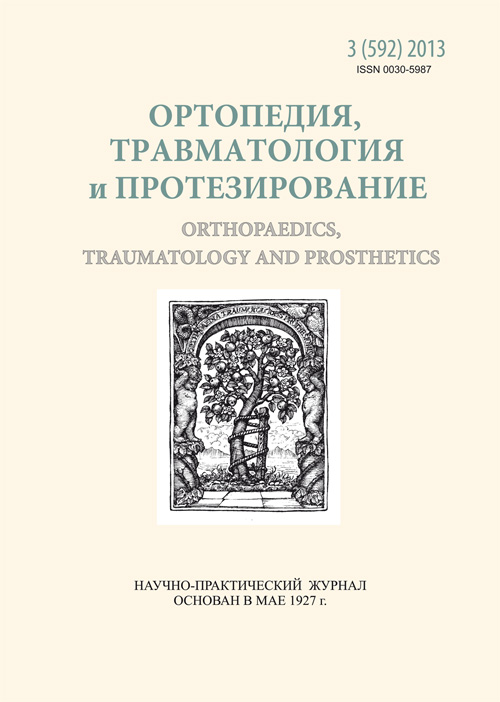A concept of low-contact multiplane osteosynthesis for diaphyseal fractures of the shin bones
DOI:
https://doi.org/10.15674/0030-59872013388-91Keywords:
fracture of the tibia, the concept of low-contact multiplanar osteosynthesisAbstract
On the basis of their biomechanical systemic analysis of contact plate designs, LCP fixators, peculiarities in the reparative regeneration course, causes for the development of complications and negative results the authors developed the concept of low-contact multiplane osteosynthesis. The latter is made with fixing plates, which have the minimum volume and length, the most optimum design and are constructed for concrete fracture lines. Restoration of the load-carrying capacity of the bone takes place with help of multiplane fixing screws, presence of elements of their interaction with the fixing plate and without any pressure on the bone from the plate. It results in a stable biomechanical construction “fixing plate – bone”, which makes it possible to program the value of micromotion of fragments and optimize the course of reparative regeneration.
References
- Bilinskiy P. I. Theory and Practice of Small-Contact Multiplane Osteosynthesis / P. I. Bilinskiy – K. Macros, 2008 – 376 p.
- Bitchiuk D. D. Experimental–Mathematical Substantiation of Multiplane Cortical Osteosynthesis in Transversal Diaphysial Tibia Fractures; author’s abstract of thesis submitted for PhD. degree in medicine: qualification 14. 01. 21. “Traumathology and Orthopaedy”. Dmitriy Denisovich Bitchiuk – Kharkov, 2007 – 27 p.
- Korzh M. O. Choice of Osteosynthesis Method in Bone Fractures / M. O. Korzh, L. D. Goridova: XII Traumatologists and Orthopaedists of Ukraine Congress – K. 1996 – p. 39-40.
- Licence № 17502 UA. IPC A61 B17/58, A61 B17/62. Device for Bone Fragments Fixation. Bilinskiy P. I. (UA); declarant and patentee P. I. Bilinskiy (UA). - №96051961; decl.20. 05. 96. pub. 31.10.97. Bull. № 5.
- Popsuishapka A. K. Dynamic Treatment of Diaphysial Bone Fractures (clinical and experimental substantiation): thesis of Doctor of Medicine 14.01.21 / Aleksei Korneevich Popsuishapka. – Kharkov, 1991. – 323 p.
- Simenach B. I. Fracturology – Some Theoretical Aspects of Bone Fractures Therapy. Part I: On Genesis of Fracture Sydrome./B.I. Simenach/ Orthopaedy, Traumatology and Prosthetics. – 2000. - №3 – p. 121-140.
- Transformation Factor of Growth (TFG) – β1 as Marker of Retarding Union of Fractures / G. Zimmemann, P. Henle, M. Kusswetter at el. // Orthopaedy, Traumatology and Prosthetics – 2009 - №1 – p.57-65.
- Shapovalov V. M. Principles of Inner Osteosynthesis / V. M. Shapovalov, V. V. Khominets, S. M. Mikhailov. – M.: GEOTAR – Media. 2009 – 235 p.
- Babst R. LISS tractor. Combination of the «less invasive stabilization system» (LISS) with the AO distractor for distal femur and proximal tibial fractures / R. Babst, M. Hehli, P. Regazzoli // Unfallchirurg. — 2001. — Bd. № 6. — P. 530–535.
- Ruedi Th. R. AO Principles of fracture management / Th. R. Ruedi, R. E. Buckly, Ch. G. Moran. — Stuttgart, New York : Thieme, 2007. — 947 р.
Downloads
How to Cite
Issue
Section
License
Copyright (c) 2014 Petro Bilinskyi, Volodymyr Chaplynskyi, Volodymyr Andreychyn

This work is licensed under a Creative Commons Attribution 4.0 International License.
The authors retain the right of authorship of their manuscript and pass the journal the right of the first publication of this article, which automatically become available from the date of publication under the terms of Creative Commons Attribution License, which allows others to freely distribute the published manuscript with mandatory linking to authors of the original research and the first publication of this one in this journal.
Authors have the right to enter into a separate supplemental agreement on the additional non-exclusive distribution of manuscript in the form in which it was published by the journal (i.e. to put work in electronic storage of an institution or publish as a part of the book) while maintaining the reference to the first publication of the manuscript in this journal.
The editorial policy of the journal allows authors and encourages manuscript accommodation online (i.e. in storage of an institution or on the personal websites) as before submission of the manuscript to the editorial office, and during its editorial processing because it contributes to productive scientific discussion and positively affects the efficiency and dynamics of the published manuscript citation (see The Effect of Open Access).














